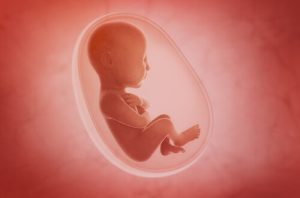Birth Defects: Types and Prevention

Fetal malformations, or birth defects, are congenital anomalies. They may be either structural or functional. They usually occur while the baby is in the uterus and are detected during pregnancy, birth or any point thereafter.
A minimal percentage of birth defects
In this day and age, most women give birth to healthy babies. This is thanks to major medical advances and public policy in developing countries.
As a result, the occurrence of fetal malformations has reduced considerably.
In many countries, congenital birth defects are the cause of infant mortality, chronic illness and disability. Chronic disabilities bear a great impact on the life of those affected, as well as their families, health systems and society in general.
According to the World Health Organization, fetal malformations represent 1 in 33 infants. An estimated 3.2 million babies with disabilities are born each year.
Early detection of these pathologies through diagnostic methods used during pregnancy is fundamental. These tests allow specialists to implement appropriate and effective therapies for many embryonic irregularities.

It’s difficult to point out a specific cause for 50% of fetal malformations. But specialists have managed to identify certain underlying factors. Socio-economics, environment, demographics, genetics, infection and the mother’s nutritional state, etc., can all play a role.
Types of birth defects
- The most common malformations: cleft lip, cleft palate, cerebral palsy, congenital hypothyroidism, fetal alcohol syndrome, or neural tube defects, including spina bifida and anencephaly.
- Heart defects Septal atrial and ventricular defects, patent ductus arteriosus, aortic stenosis, and coarctation of the aorta. Also, transposition of great vessels, hypoplastic left heart syndrome, and tetralogy of Fallot.
- Gastrointestinal tract defects: Esophageal atresia, congenital diaphragmatic hernia, pyloric stenosis, Hirschsprung’s disease, gastroschisis, omphalocele, imperforate anus, and biliary atresia.
- Congenital disorders: Cystic fibrosis, Down syndrome, X-fragile syndrome, muscular dystrophy, phenylketonuria, sickle cell anemia, Tay-Sachs disease, etc.
- Infections that can cause fetal malformations: Congenital rubella syndrome, cytomegalovirus, toxoplasmosis, genital herpes, fifth disease, chicken pox, congenital syphilis.
Detection
Detection of these pathological processes can take place during the following periods:
- The period of preconception.
- The period of conception. Includes basic reproductive health practices, genetic testing and counseling.
- During the neonatal period.
Attention and treatment
Pediatric surgical interventions can correct a great number of structural congenital anomalies, such as cleft palate.
Medical professionals can also administer early treatment to children with functional alterations, like thalassemia and congenital hypothyroidism.
Prevention of birth defects
Preventative public health policies and campaigns offered by different areas of health and sanitation are very effective at preventing fetal malformations.
The implementation of these policies has reduced the occurrence of birth defects. Some of these measures include:
- Modifying the diet of women of childbearing age, guaranteeing the consumption of vital minerals and vitamins, such as folic acid.
- Guaranteeing that pregnant women do not consume substances that can be harmful to the developing baby. These harmful substances include – but are not limited to – drugs, alcohol and tobacco.

- Attending regular doctor’s visits and completing necessary testing before conception and throughout pregnancy. This will help to detect and control conditions like diabetes mellitus, which can be managed through a specific diet.
- Reducing or avoiding exposure to harmful substances, such as heavy metals or insecticides, during pregnancy.
- Controlling exposure to radiation (and intake of pharmaceuticals during pregnancy). Exposure/intake must always be evaluated beforehand in regards to risks and benefits to the health of both mother and baby.
- Improving programs that promote health, including making vaccines more accessible. Especially vaccines against the rubella virus in women and girls. Childhood rubella vaccines are effective in preventing the disease. If a woman has not had the disease, she can receive the anti rubella vaccine during pregnancy.
Science has made giant leaps in recent years. Birth defects are less and less common thanks to advances in science. However, it’s important to prevent or detect any pathology early on – before, during or after pregnancy
All cited sources were thoroughly reviewed by our team to ensure their quality, reliability, currency, and validity. The bibliography of this article was considered reliable and of academic or scientific accuracy.
- Lafarge, Caroline et al. “Pregnancy termination for fetal abnormality: are health professionals’ perceptions of women’s coping congruent with women’s accounts?.” BMC pregnancy and childbirth vol. 17,1 60. 8 Feb. 2017, doi:10.1186/s12884-017-1238-3.
- Paladini, Dario & Volpe, Paolo. (2014). Ultrasound of Congenital Fetal Anomalies: Differential Diagnosis and Prognostic Indicators. Second Edition. 10.1201/b13793-8.
- Pooh, Ritsuko. (2013). Early Detection of Fetal Abnormality. Donald School Journal of Ultrasound in Obstetrics & Gynecology. 7. 46-50. 10.5005/jp-journals-10009-1269.
This text is provided for informational purposes only and does not replace consultation with a professional. If in doubt, consult your specialist.








